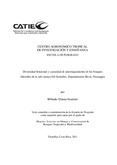Diversidad funcional y capacidad de amortiguamiento de los bosques ribereños de la subcuenca Gil González, Departamento de Rivas, Nicaragua
Alternative title
Functional diversity and buffering capacity of riparian forests in Gil Gonzalez sub-basin, Department of Rivas, Nicaragua
Description
Tesis (Mag.Sc.) -- CATIE, 2011
Abstract
Se determinaron los diferentes tipos de vegetación presentes en la zona ribereña de la cuenca del río Gil Gonzales, mediante análisis espectral de imágenes ASTER, utilizando índices espectrales como el índice de vegetación normalizado, albedo y Transformación tasseled cap. En cada tipo de vegetación se instalaron parcelas de 30 * 30 m y se evaluaron variables florísticas y estructurales y rasgos funcionales relacionados a la capacidad de absorción de nutrientes y retención de sedimentos. Se aplicó un modelo de costo-distancia para determinar la distribución espacial de la capacidad de amortiguamiento a lo largo de la zona ribereña, para esto se utilizó como variables de fricción a los valores promedio de las variables de estructura de la vegetación y rasgos funcionales.Concluimos que la capacidad de amortiguamiento es una función determinada principalmente por el el ancho de la vegetación y la pendiente, siendo la estructura de la vegetación así como la diversidad funcional, factores complementarios para definir la capacidad de amortiguamiento. Different types of vegetation in the riparian zone of the Gil Gonzales river basin were determined using a spectral analysis of ASTER images with spectral indexes and the normalized vegetation index, return light ratio and Tasseled Cap Transformation. In each type of the vegetation, plots measuring 30 * 30 m were installed and the floristic and structural variables and functional traits related to the ability to absorb nutrients and sediment retention were evaluated. Also, a cost-distance model was applied to determine the spatial distribution of the buffering capacity along the riparian area. For this purpose, the average values of the vegetation structure and functional traits were used as friction variables. Five different vegetation types, well differentiated in structure and distribution of functional traits, were determined. It was concluded that the buffering capacity is a function mainly determined by the vegetation width and slope being the vegetation structure as well as the functional diversity additional factors used to define the buffering capacity.
Keywords
Publisher
CATIE, Turrialba (Costa Rica)
URI (Permanet link to cite or share this item)
https://repositorio.catie.ac.cr/handle/11554/2204Collections
- Tesis [3110]


